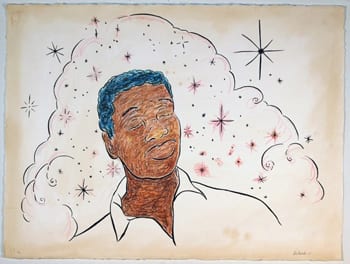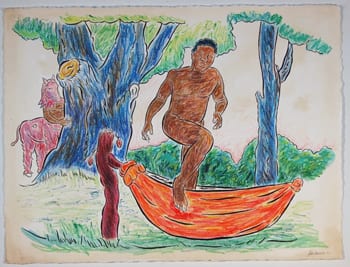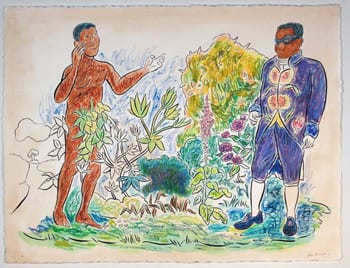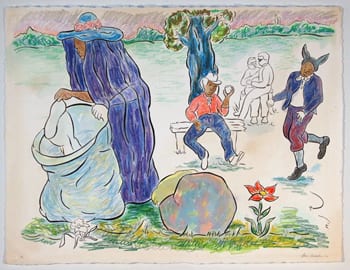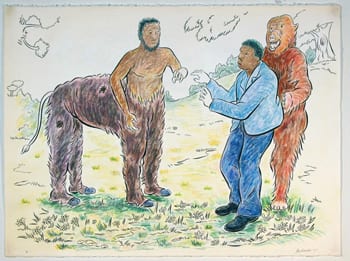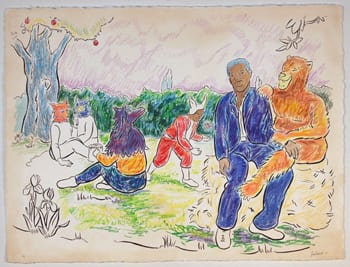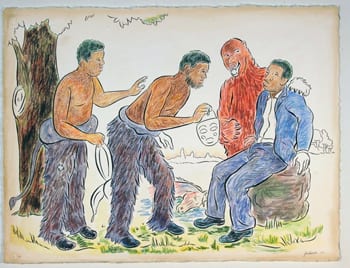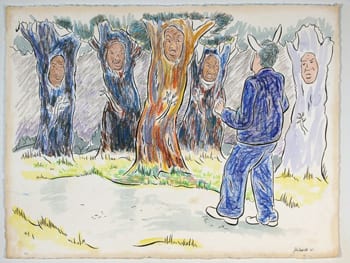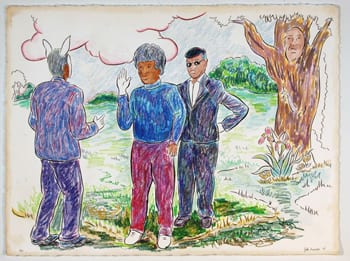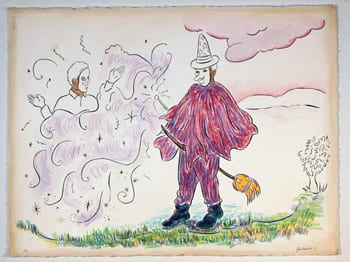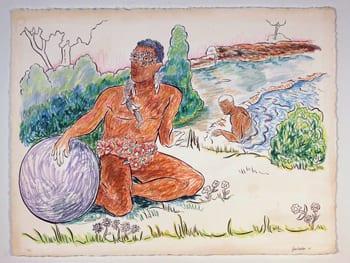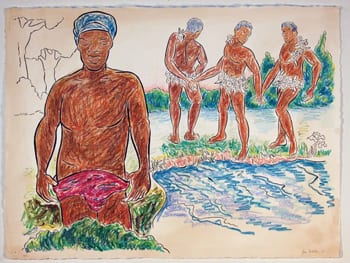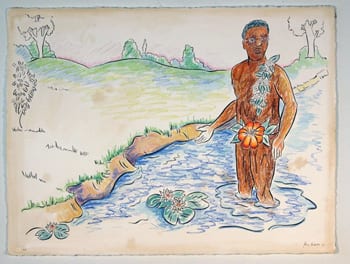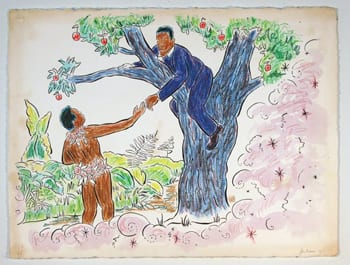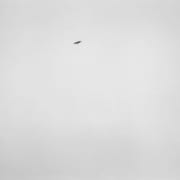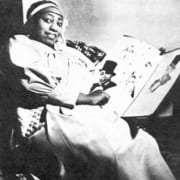John Bankston
John Bankston: Locating Desire, is the second in a series of Connections Gallery exhibitions at the de Young Museum.
According to Daniell Cornell, curator of American Art and Director of Contemporary Art Projects, “The Museum asks the Connections Gallery artists to think about their own experience as museum visitors, and to incorporate into their own work objects from the museum’s collection. There are as many ways to go through a museum as there are artists to interpret the cultural life we share.” John Bankston: Locating Desire is an installation of twenty 23 x 30 1/2 inch works on paper in color pencil, watercolor, oil pastel and acrylic, as well as four oil on linen paintings, two 72 x 96 inch and two 66 x 60 inch.
Animated by his own desires – to touch, own, and create – Bankston imagines a fictional character whose experiences while visiting the museum lead him on a fantasy journey that incorporates the artworks he finds most enticing: visually, emotionally and psychologically. Based on these imaginary travels, Bankston creates a narrative in drawings and oil paintings, juxtaposing disparate parts of the museum in surprisingly humorous but telling ways. Together these works make up a visual narrative of the fantasy journey Bankston’s fictional character takes while visiting the museum.
John Bankston describes his paintings and drawings as works that engage the visual language of coloring books. He explains the formal use of this idiom as allowing him to integrate painting and drawing, representation and abstraction. By inviting museum visitors to follow his fantasy narrative, Bankston encourages visitors to re-imagine their own worlds. Says Bankston: “The idea of ‘fantasy’ is often thought of as the province of idle escapists. But I like to think of fantasy as a way of re-imagining our world. It is a means of stepping outside of one’s known territory and breaking boundaries.”
Working in drawing and painting, Bankston is inspired by the idea of the museum as a world of objects enticingly displayed but unobtainable. In preparation for this exhibition, John Bankston met several times with FAMSF curator Daniell Cornell, to search the de Young’s collection database and identify works of particular interest to him. Bankston also spent time in Golden Gate Park, sketching the museum’s physical environment. The resulting body of work reflects John Bankston’s investigations and observations, absorbing elements from works in the de Young’s American art, African art, Oceanic art and Textiles collections, as well as the museum’s park surroundings.
About John Bankston
John Bankston is a San Francisco-based artist, whose work is exhibited internationally. Winner of a 2002 SECA Award from the San Francisco Museum of Modern Art, as well as a Fleishhacker Eureka Fellowship, his work has been shown at the The Studio Museum in Harlem, the Andy Warhol Museum, the Crocker Art Museum, The Contemporary Jewish Museum, and Yerba Buena Center for the Arts, among other museums and galleries world-wide.
About the Connections Gallery
Situated at the intersection of the galleries for the de Young’s three primary departments (Textiles, American Art, and Art of Africa, Oceania and the Americas), the Connections Gallery is a newly conceived, ongoing exhibition space that engages viewers through strong visual connections.
Through the Connections Gallery program, three artists a year are invited to develop a body of work using the museum’s permanent collection as source material. The resulting exhibitions of site-specific work reinterpret the de Young’s collections within a contemporary context. The gallery’s location emphasizes the integrated nature of the permanent collection. The Connections Gallery signals the new de Young’s vitality as a dynamic forum for contemporary art and reflects its involvement in the current discourse of museum presentation and display.
John Bankston: Locating Desire
Most museum visitors probably remember their childhood experiences with coloring books fondly and nostalgically. Who can forget that seemingly sacred injunction to keep one’s coloring “inside the lines?” What child did not chafe under the restrictive expectations of adults about the appropriate colors that should be used to enliven the simple line drawings? And who was ever disciplined enough to color each page methodically with the same degree of care as the storyline unfolded? However, it is probably safe to assume that few people come to the museum expecting to find themselves face to face with such memories in the literal fashion represented by John Bankston’s artworks.
Bankston’s works rely on the viewer’s recognition that he has taken the look of them from coloring books. That commonplace experience of most children in modern American culture informs both the style and the rhetorical strategies implicit in his works’ meanings. However, this juvenile form carries anything but childish implications. Rather, Bankston relies on the familiar codes and narrative assumptions inherent within coloring books to explore seemingly unrelated fine art genres and the role of subjectivity in establishing the relationship between knowledge and imagery. By examining the rhetoric of the coloring book, we can ascertain some of the most significant ways that color and line inflect painting with meaning. Such an examination also leads to more sociological questions about the preconditions for different creative practices and the institutional purposes underlying museum display.
A Fantastic Journey
Beginning with drawings, Bankston builds a fantasy world out of characters and settings that emerge from his imagination. In the past, he has drawn on fairy tales, animal fables, adventure voyages, and science fiction when inventing the realms for his magical story lines. He allows an initial setting and an imaginary protagonist to interact, mutually informing the suggestive possibilities that define the direction of a fanciful narrative. At times the characters evoke the world of their actions, but other times Bankston relies on the scenario to prompt his plots. Bankston’s drawings operate as a space of inventive play where his unconscious can find visual expression. In this way, they function more directly as creative spurs than the preliminary drawings that most artists use merely to work out details of form, composition, and style for more finished works, often large-scale paintings.
The sequence of drawings in this project begins with a narrative character who stands in front of a pair of paintings that suggest American landscapes and confronts one of the de Young’s astonishing African objects, a cocoa-pod coffin from Ghana (no. 1). Overcome with the possibilities of wonder, mystery, and adventure that the coffin generates, the protagonist falls into a reverie, incorporating this object and many of the museum’s other works of art into a fantasy world where different levels of desire converge (figs. 1, 2). These desires are social, political, and artistic, raising issues related to the protagonist’s sexual, racial, and creative identity. Bankston traces the narrative thread of his imaginary journey through the museum, blurring fact and fiction in a series of twenty linked drawings.
As in many fairy tales or fantastic journeys, the protagonist awakens naked in a strange landscape, metaphorically suggesting his vulnerability and inner transformation as he embarks on a series of symbolic encounters that represent his unconscious (no. 3). He initially meets a friendly stranger dressed in a seventeenth-century gentleman’s court suit (fig. 3; no. 4) who provides clothing and introduces him to a diverse group of unusual characters that populate an Alice-in-Wonderland-like world, all of whom are male and dressed in masquerade (no. 8). At first glance the costumes appear familiar, but on closer inspection they blur distinctions of all kinds, including historical periods, social types, and species.
A bear and two men in a horse suit become the main character’s guide, providing him with a mask of his own––a reminder of the many masks in the museum’s AOA collection––and taking him through an enchanted wood (fig. 4; no. 10). In the forest, symbolic of the museum, many of his desires are stirred and yet frustrated by his inability to act on them. Eventually meeting a witch, the protagonist requests a transformation that will fulfill his desires and finds himself in a realm suggested by the museum’s Oceanic collection, which he experiences as an enchanted land of exoticized sexuality that recalls Gauguin’s visions of Tahiti, his nineteenth-century appropriation of South Sea Island cultures (no. 18). In the end, the protagonist is invited to leave his position in a tree, where he is a passive observer, and participate in the fantastic world of desires and possibilities conjured by the museum and summarized for Bankston in the painting Boy Party (fig. 5; no. 23).
Desire and Lack
Bankston’s engagement with the unconscious connects his creative process to his subject matter. Psychoanalytic theories point to the unconscious as the seat of desire, and Bankston’s persistent theme is desire and its role in the formation of identity. In the case of this project, he begins with the museum as a world of desire. He says, “In this world, objects are enticingly displayed but cannot be touched. It is a place of constant desire; the desire to touch/experience, the desire to own, the desire to create.” The individual scenes that unfold in his drawings suggest a crisis of desire that is based on the missing component necessary for completion or fulfillment. In psychoanalytic terms it is known as the “lack,” which is the external supplement that an individual recognizes is necessary for a sense of self. Bankston ingeniously explores how the objects in the museum mobilize this notion of the lack as a rhetorical device that allows him to reinvent possibilities and imagine new identities.
The coloring book is central to this discussion of lack because it is basically a series of images that lack color. Its pages of line drawings are completed through the act of coloring, which provides a source of pleasure by allowing the child to supply what is missing. This notion of lack thus functions in a dual capacity as both the literal absence of color that must be supplied and the symbolic fulfillment of desire in the psychoanalytic narrative of identity. In this way, Bankston’s paintings and drawings enact the very terms of their own meaning, combining an investigation of the terms of artistic representation with the structuring of identity.
The coloring book’s division of line and color establishes a basic rubric of oppositional meaning that extends to our culture’s major social divisions––adult and child, white and black, male and female, heterosexual and queer. In other words, the look of our world as it is figured to us in painting and drawing is inscribed through the very aesthetics of fine art itself. Not merely a reflection of what actually exists, fine art aligns viewers with particular subjective positions that replace their own, determining in advance which narrative desires and fantasies are available when framing one’s understanding of reality. Something of Bankston’s sly manipulation of this theme may be seen in his emphasis on the transformation of the book’s white pages, which are only considered complete when they have been colored. This reference to racial discourse reverses the usual priority of whiteness in a manner that Bankston, as an African American, underscores even further through the narrative’s characters.
Colorful Alternatives
At the same time, these works are very much about the conventions of painting and drawing and how they operate as signifying media. The drawings combine colored pencil, watercolor, oil pastel, and acrylic to create their multiple effects. In the delineations of form, the softness of the oil pastel contrasts with the hardness of the colored pencil. The delicate translucency of watercolor plays off the opaque reflectivity of acrylic. In a similar manner, the paintings engage with the genre’s history. They are loaded with vibrant color, even more replete than expected. Bankston has left little white space, pushing pure color deep into the landscape settings as if to ask how we determine foreground from background. We see the same line repeated, continually changing its visual meaning from grass to fur to cloth to clouds and so on. However, it is not color that determines the meaning, which Bankston makes evident in his arbitrary and variable hues. Rather, his color functions as a reminder that the principal role of painting is to represent the experience of reality, not to duplicate it.
Bankston performs numerous other discursive operations on the objects he encounters within the museum. Instead of relating artworks to the external world from which they were removed in order to be displayed, he wholeheartedly embraces the condition of the museum as a decontextualized space, finding meaning for these objects in the network of relations that they establish with each other. At times Bankston’s references to objects in the museum are obvious, as when he incorporates the cocoa-pod coffin into his painting of awakening and transformation (no. 21) or directly references Jess’s Boy Party in his use of its compositional structure as a setting for the protagonist’s sexual fantasies (no. 23).
At other times Bankston’s appropriations are less obvious, as in the depiction of the character’s journey with the bear and men in the horse suit through a lush and strange setting that recalls the manipulated terrain of nineteenth-century American landscape painters (no. 24; figs. 6, 7). And in some works Bankston uses fantasy to capture the emotional experience that the museum elicits more generally, as in the painting that references his visit to the textile gallery, which represents the unmasking of sexual desires by placing the Mardi Gras figure in a forest of phallic-bearing trees (no. 22).
By making entirely new and arbitrary associations, Bankston points up how signifiers operate within a closed field defined by a shared network of associations that generate their meaning. He creates the possibilities that question the notions of reality visitors bring into the museum. Traveling with Bankston’s protagonist on his imaginary journey reveals that the realm from which artworks supposedly come to museums as ambassadors of truth is as much of a fantasy as a coloring-book world.
-Daniell Cornell, Director of Contemporary Art Projects
The Connections Gallery
The Connections Gallery is a newly conceived, ongoing exhibition area that is designed to enable visitors to make connections through visual experiences. For each installation in this project space, an artist is asked to identify artworks from the collection and incorporate them into works that reveal his or her personal experience as a museum visitor. The resulting installation offers viewers a model for reinterpreting the objects on display and provides a catalyst for new ways of bridging history and contemporary experience.
About the Artist
John Bankston uses drawing and painting to explore imaginary narrative structures, such as fantasy, adventure stories, science fiction, fables, and folk tales. His aesthetic relies on the visual language associated with children’s coloring books, but the imagery, subject matter, and characters shift the content of his works into the domain of adult concerns. By drawing on multiple sources, Bankston creates symbolic realms that combine innocence and transgression to reveal the constraints of normative values. Crossing boundaries, literally and metaphorically, he reinvents what is possible and transforms our idea of the world.
Bankston received his M.F.A. in painting from the School of the Art Institute of Chicago in 1990. In addition to solo exhibitions at the Studio Museum in Harlem, New York, and the Atlanta College of Art, Georgia, he has participated in many group shows, including Freestyle (the Studio Museum in Harlem); Splat, Boom, Pow (Contemporary Arts Museum, Houston); and Comic Release (Carnegie Mellon University, Pittsburgh). Among his numerous awards are an Outstanding Ford Foundation Fellowship, a SECA Art Award from the San Francisco Museum of Modern Art, and a Joan Mitchell Foundation Grant. His works are represented in the collections of the Berkeley Art Museum; the City of Chicago; the Norton Family Foundation, Santa Monica; the San Francisco Museum of Modern Art; the Studio Museum in Harlem; and the University of Illinois, Chicago.
Checklist of the Exhibition
All works are courtesy of Rena Bransten Gallery, San Francisco, and Jack Shainman Gallery, New York.
1–20. No. 1–No. 20, 2005
20 drawings: each color pencil, watercolor, oil pastel, acrylic on paper, approx. 23 x 30 1/2 in.
21. Arise, 2005
Oil on linen, 66 x 60 in.
22. Unmasked, 2005
Oil on linen, 66 x 60 in.
*Note: This on-line version of John Bankston’s installation reflects the titles and numbering system used by the de Young Museum.



